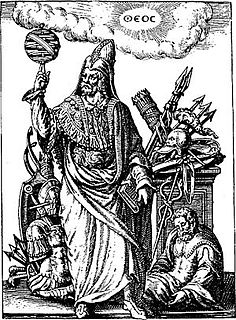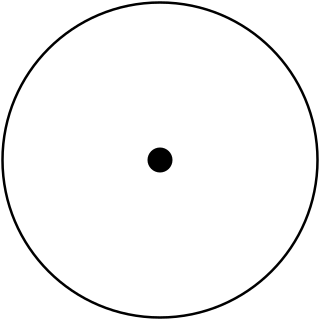
Keter also known as Kether, is the topmost of the Sephirot of the Tree of Life in Kabbalah. Since its meaning is "crown", it is interpreted as both the "topmost" of the Sephirot and the "regal crown" of the Sephirot. It is between Chokhmah and Binah and it sits above Tiferet. It is usually given three paths, to Chokhmah, Tiferet and Binah.

Sefirot, meaning emanations, are the 10 attributes/emanations in Kabbalah, through which Ein Sof reveals Itself and continuously creates both the physical realm and the chain of higher metaphysical realms. The term is alternatively transliterated into English as sephirot/sephiroth, singular sefirah/sephirah etc.

Da'at or Daas is a word in the Hebrew language. In the branch of Jewish mysticism known as Kabbalah, Da'at is the location where all ten sefirot in the Tree of Life are united as one.

Ein Sof, or Eyn Sof, in Kabbalah, is understood as God prior to any self-manifestation in the production of any spiritual realm, probably derived from Solomon ibn Gabirol's term, "the Endless One". Ein Sof may be translated as "unending", "(there is) no end", or infinity. It was first used by Azriel, who, sharing the Neoplatonic belief that God can have no desire, thought, word, or action, emphasized by it the negation of any attribute. Of the Ein Sof, nothing ("Ein") can be grasped ("Sof"-limitation). It is the origin of the Ohr Ein Sof, the "Infinite Light" of paradoxical divine self-knowledge, nullified within the Ein Sof prior to creation. In Lurianic Kabbalah, the first act of creation, the Tzimtzum self "withdrawal" of God to create an "empty space", takes place from there. In Hasidic Judaism, the Tzimtzum is only the illusionary concealment of the Ohr Ein Sof, giving rise to monistic panentheism. Consequently, Hasidism focuses on the Atzmus divine essence, rooted higher within the Godhead than the Ein Sof, which is limited to infinitude, and reflected in the essence (etzem) of the Torah and the soul.

Chokmâh is the Biblical Hebrew word rendered as "wisdom" in English Bible versions.

Tiferet alternatively Tifaret, Tifereth, Tyfereth or Tiphereth, is the sixth sefira in the kabbalistic Tree of Life. It has the common association of "Spirituality", "Balance", "Integration", "Beauty", "Miracles", and "Compassion".
Atziluth or Atzilut, is the highest of four worlds in which exists the Kabbalistic Tree of Life. Beri'ah follows it. It is known as the World of Emanations, or the World of Causes. In the Kabbalah, each of the Sephiroth in this world is associated with a Name of God, and it is associated with the Suit of Wands in the Tarot.

Malkuth, Malchut or Malchus, also identified as Shekhinah, is the tenth of the sephirot in the Kabbalistic Tree of Life. It sits at the bottom of the Tree, below Yesod. This sephirah has as a symbol the Bride which relates to the sphere of Tipheret, symbolized by the Bridegroom.

Yesod is a sephirah or node in the kabbalistic Tree of Life, a system of Jewish philosophy. Yesod, located near the base of the Tree, is the sephirah below Hod and Netzach, and above Malkuth. It is seen as a vehicle allowing movement from one thing or condition to another. Yesod, Kabbalah, & the Tree of Life are Jewish concepts adopted by various philosophical systems including Christianity, New Age Eastern-based mysticism, & Western esoteric practices.
Sathariel is one of the Qliphoth, corresponding to the Sephirah Binah on the kabbalistic Tree of life. It represents the Concealment of God, which hides the face of Mercy. The form of the demons attached to this Qliphah are of black veiled heads with horns, with hideous eyes seen through the veil, followed by evil centaurs.
A'arab Zaraq is the Qliphah corresponding to the Sephirah Netzach on the Kabbalah's tree of life. It translates as 'The Ravens of Dispersion', and the demons associated with it are hideous, demon-headed ravens issuing forth from a volcano.

The tree of life is a diagram used in various mystical traditions. It usually consists of 10 nodes symbolizing different archetypes and 22 lines connecting the nodes. The nodes are often arranged into three columns to represent that they belong to a common category.

In Kabbalistic and Hasidic philosophy, seder hishtalshelus or hishtalshelut refers to the chain-like descent of spiritual worlds (Olam/Olamot) between God and Creation. Each spiritual world denotes a complete realm of existence, resulting from its general proximity or distance to Divine revelation. Each realm is also a form of consciousness reflected in this world through the psychology of the soul.

Lurianic Kabbalah is a school of kabbalah named after the Jewish rabbi who developed it: Isaac Luria. Lurianic Kabbalah gave a seminal new account of Kabbalistic thought that its followers synthesised with, and read into, the earlier Kabbalah of the Zohar that had disseminated in Medieval circles.
The Four Worlds, sometimes counted with a prior stage to make Five Worlds, are the comprehensive categories of spiritual realms in Kabbalah in the descending chain of Existence.

Hermetic Qabalah is a Western esoteric tradition involving mysticism and the occult. It is the underlying philosophy and framework for magical societies such as the Golden Dawn, Thelemic orders, mystical-religious societies such as the Builders of the Adytum and the Fellowship of the Rosy Cross, and is a precursor to the Neopagan, Wiccan and New Age movements.The Hermetic Qabalah is the basis for Qliphothic Qabala as studied by left hand path orders, such as the Typhonian Order.

Ayin is an important concept in Kabbalah and Hasidic philosophy. It is contrasted with the term Yesh ("something/exist/being/is"). According to kabbalistic teachings, before the universe was created there was only Ayin, and the first manifest Sephirah, Chochmah (Wisdom), "comes into being out of Ayin." In this context, the sephirah Keter, the Divine will, is the intermediary between the Divine Infinity and Chochmah. Because Keter is a supreme revelation of the Ohr Ein Sof, transcending the manifest sephirot, it is sometimes excluded from them.

Olam HaTohu and Olam HaTikun are two general stages in Jewish Kabbalah, in the order of descending spiritual Worlds (Olamot). In subsequent creation they also represent two archetypal spiritual states of being and consciousness. Their concepts derive from the new scheme of Lurianic Kabbalah by Isaac Luria (1534–1572), the father of modern Kabbalah, based on his interpretation of classic references in the Zohar.




